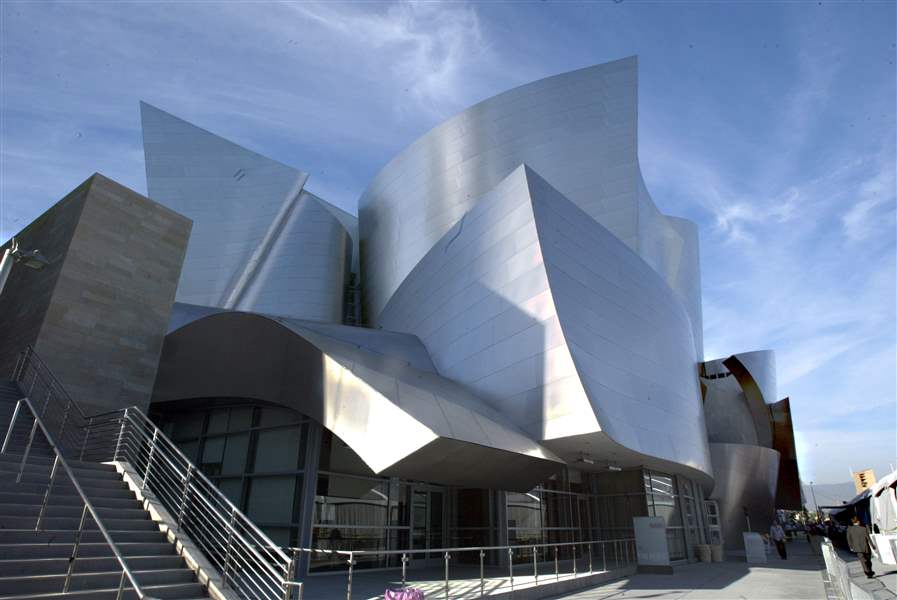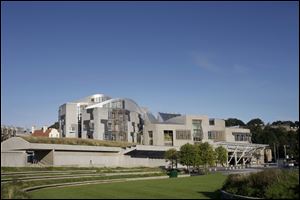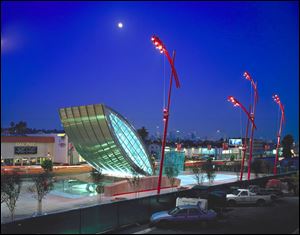
Ambitious building designs invite debate
Noted architects often spark controversy
6/15/2011
The Walt Disney Concert Hall in Los Angeles, which opened in 2003, was designed by architect Frank Gehry, who also designed the University of Toledo Center for Visual Arts.
Getty Images

The design of the Scottish Parliament won Britain's Stirling Prize for its contribution to British architecture, despite discoveries of structural flaws. Its $623 million price tag far exceeded initial estimates.
Any controversy that arises from architect Mehrdad Yazdani's design for a new federal courthouse in Toledo will be in line with a rich history of pitfalls and triumphs surrounding ambitious modern structures.
Some of these more ambitious buildings have radically exceeded their initial estimates, appeared at odds with the rest of the environment, and produced unexpected issues.
At the $274 million Walt Disney Concert Hall in Los Angeles, which was finished in 2003 and designed by architect Frank Gehry, adjacent buildings began overheating as the concert hall's twisting metal surfaces accidentally focused sunlight on businesses nearby. Sections of the metal were sanded down so that the light would diffuse more easily.
RELATED ARTICLE: Design set for federal courthouse

The Walt Disney Concert Hall in Los Angeles, which opened in 2003, was designed by architect Frank Gehry, who also designed the University of Toledo Center for Visual Arts.
Mr. Gehry also designed the Hotel Marques de Riscal Vineyard Hotel in Elciego, Spain, whose titanium and stainless steel layers are shaded to echo the colors of wine bottles, and the Guggenheim Museum in Bilbao, Spain, which a Vanity Fair survey of architects and other experts concluded was the most important work of architecture since 1980. He also designed the University of Toledo Center for the Visual Arts, adjacent to the Toledo Museum of Art. The design was controversial at the time.
The Scottish Parliament Building in Edinburgh, designed by Enric Miralles, opened three years late in 2004.
Though the building won the Stirling Prize, an annual award for the most important contribution to British architecture, the structure cost more than 10 times its original estimate -- with a more than $623 million price tag. Two years later, a wooden roof beam above the main chamber came loose and hung over the heads of Parliament members. When officials removed the beam for inspection, they found other minor structural faults.
I. M. Pei's 71-foot-high glass pyramid at the center of the Louvre's courtyard in Paris might seem at odds with the museum's surrounding centuries-old facade.

Mehrdad Yazdani designed a subway station with artist Robert Millar in Los Angeles. The station at Vermont Avenue and Santa Monica Boulevard is defined by a 30-foot tall, eye-shaped metal canopy perched over the entrance.
The addition, perched over an underground visitor hub, has served as the entrance to the famous art museum since the structure was finished in 1989. Paul Goldberger of the New York Times wrote that the work echoes the Eiffel Tower in its concern for monumentality.
Other modern architecture might have found ways to interact with nearby landmarks.
Mr. Yazdani also designed a subway station with artist Robert Millar in Los Angeles. The station is defined by a 30-foot tall, eye-shaped metal canopy perched over the entrance, but Mr. Millar told the Los Angeles Times that the underground space would seem to expand with the help of sunlight shining through a skylight and artwork on the ceiling made of glass and aluminum.
The station also pays homage to local landmarks such as the Griffith Observatory.